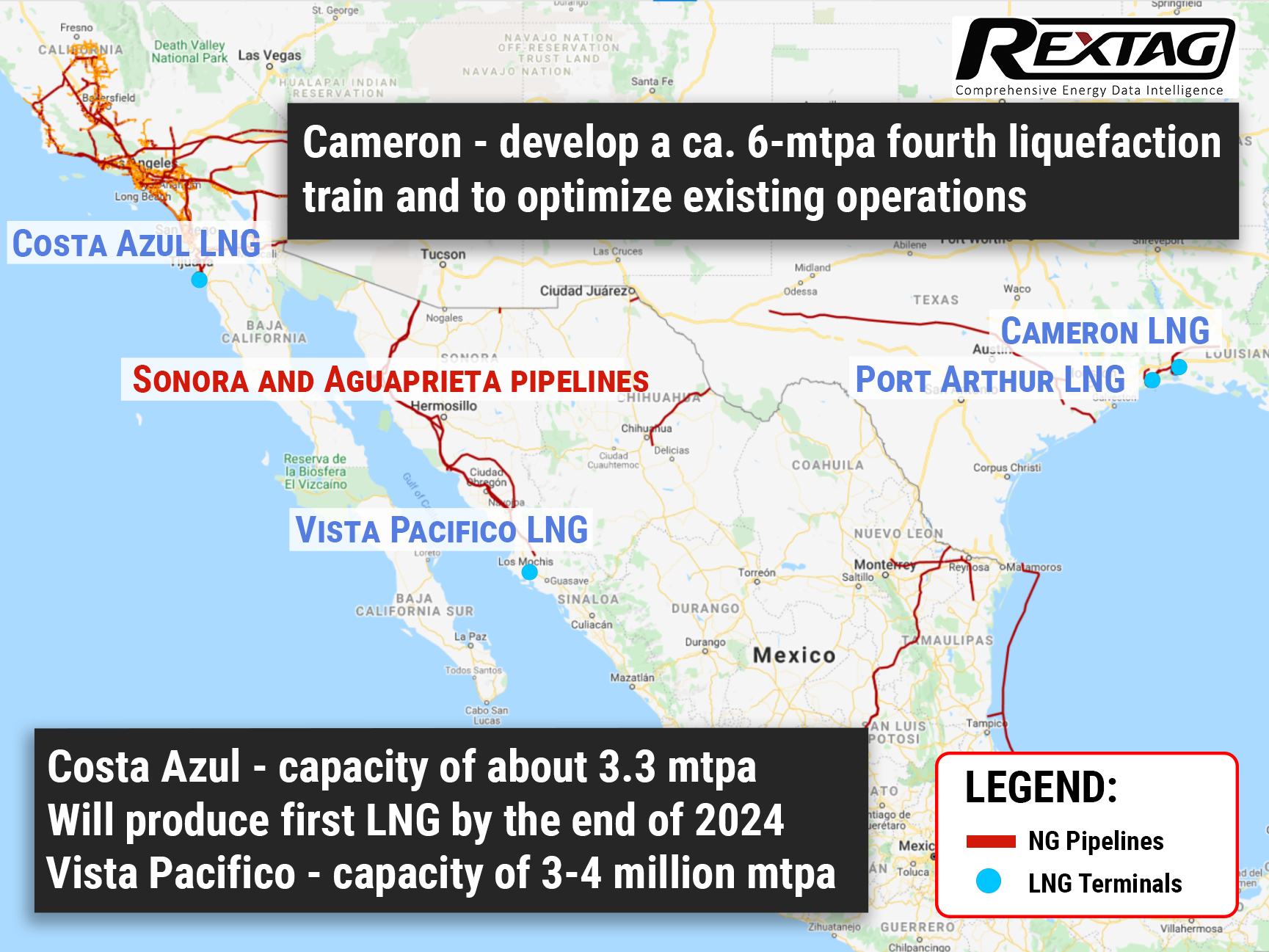Comprehensive Energy Data Intelligence
Information About Energy Companies, Their Assets, Market Deals, Industry Documents and More...
Pivot to the South: LNG Plants Under Development by Sempra Energy in Louisiana and Mexico
11/18/2021
Sempra Energy, one of the key U.S. gas exporters, announced earlier in the month that it will continue to build liquefied natural gas (LNG) export plants in Louisiana and Mexico, while also continuing to develop Phase 1 of the Costa Azul LNG export plant in Mexico.
At the company's earnings call, Justin Bird, CEO of Sempra Infrastructure, assured that Costa Azul would produce its first LNG by the end of 2024. After completion, It is expected that Costa Azul will produce approximately 3.3 million tonnes of LNG per annum.
In addition, Sempra would develop the 4.0-mmtpa Vista Pacifico LNG export facility located next to the company's Terminal for Refined Products in Topolobampo.
A slated pipeline connecting Vista Pacifico to two existing grids would simultaneously provide gas from the Permian basin in Texas and New Mexico to Asian markets that are seeing a rapid increase in LNG demand.
Vista Pacifico is being built in conjunction with the Energia Costa Azul (ECA) LNG project currently under construction in Baja California, for which the company has been awarded permits by the U.S. Energy Department to export to countries with an FTA, approval for non-FTA countries is expected in the coming months.
A mid-size LNG facility, Vista Pacifico would be supplied with lower-cost natural gas from the Permian Basin to export to high-demand Asian markets. Business operations associated with it will fall under the Sempra Infrastructure business platform.
Sempra Energy officials also assured that they will continue to be focused on putting together a roughly 6- million ton-per-annum fourth train at Cameron LNG, as well as optimizing operation at the 15- million ton-per-annum, three-train facility in Louisiana.
It was mentioned that both the Vista Pacifico project and the Cameron expansion might be sanctioned before the Port Arthur LNG project in Texas.
With regards to LNG-related inquiries from customers, the company sees a real increase in requests directed not only from Asia but from Europe and South America as well. In line with this, Sempra's long-term LNG development forecast suggests that the demand for LNG will grow between mid-to-high single digits.
Once marketing begins, Sempra's management expects Vista Pacifico to be oversubscribed.
Additionally, according to the company's analytics, there's a tremendous amount of recognition about the role of natural gas and specifically, LNG in Europe at the moment. And there's certainly a new risk premium being assigned to pipeline gas. This sentiment also plays a favorable role in the company's outlook.
In particular, October saw prices for natural gas in Europe and Asia reach record highs for the first time in a while. Delays in pipeline gas flowing from Russia is one of the reasons for such hasty change among the EU-nations politics as well as the reason behind boosted gas fees, as cited by the company's CEO.
Therefore Sempra Energy's comfortable position is a direct result of good market decisions, given that the company's capacity to deliver energy directly into Europe and Asia edges out most of its direct competitors in respective regions.
If you are looking for more information about energy companies, their assets, and energy deals, please, contact our sales office mapping@hartenergy.com, Tel. 619-349-4970 or SCHEDULE A DEMO to learn how Rextag can help you leverage energy data for your business.
13 years is not long enough: Glencore and Cheniere Sign Long-Term LNG Deal
![$data['article']['post_image_alt']](https://images2.rextag.com/public/blog/Cheniere_Energy_Sinochem_Cheniere_Marketing_Glencore.png)
Texas Cheniere and Swiss Glencore had entered into a free-on-board agreement for approximately 0.8 million tonnes of LNG per annum, starting in April 2023 for 13 consecutive years. This SPA demonstrates the commercial momentum Cheniere has been enjoying and marks an important milestone, as the company lays the groundwork for a final investment decision on Corpus Christi Stage 3, which is expected to occur next year.
Welcome 2024: A Look Back at 2023 Top Oil and Gas Sector Deals
![$data['article']['post_image_alt']](https://images2.rextag.com/public/blog/Post 218 (blog) Welcome 2024_ A Look Back at 2023 Top Oil and Gas Sector Deals.png)
2023 was quite a year for the oil and gas sector, with some big deals making the news. In the US, giants like ExxonMobil and Chevron grabbed headlines with their plans to acquire companies like Pioneer and Hess. Internationally, ADNOC wasn't left behind, expanding its reach as well. As we ring in the new year, let's recap the biggest oil and gas deals of 2023.
![$data['article']['post_image_alt']](https://images2.rextag.com/public/blog/328_Blog_Why Are Oil Giants Backing Away from Green Energy Exxon Mobil, BP, Shell and more .jpg)
As world leaders gather at the COP29 climate summit, a surprising trend is emerging: some of the biggest oil companies are scaling back their renewable energy efforts. Why? The answer is simple—profits. Fossil fuels deliver higher returns than renewables, reshaping priorities across the energy industry.
![$data['article']['post_image_alt']](https://images2.rextag.com/public/blog/327_Blog_Oil Market Outlook A Year of Growth but Slower Than Before.jpg)
The global oil market is full of potential but also fraught with challenges. Demand and production are climbing to impressive levels, yet prices remain surprisingly low. What’s driving these mixed signals, and what role does the U.S. play?
![$data['article']['post_image_alt']](https://images2.rextag.com/public/blog/326_Blog_USA Estimated Annual Rail CO2 Emissions 2035.jpg)
Shell overturned a landmark court order demanding it cut emissions by nearly half. Is this a victory for Big Oil or just a delay in the climate accountability movement?